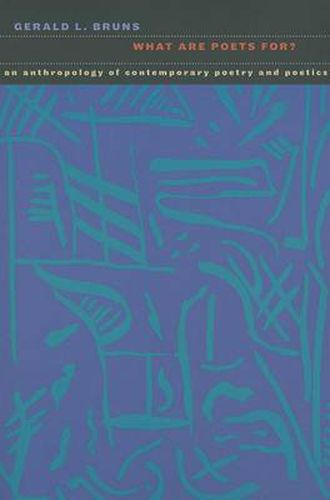Readings Newsletter
Become a Readings Member to make your shopping experience even easier.
Sign in or sign up for free!
You’re not far away from qualifying for FREE standard shipping within Australia
You’ve qualified for FREE standard shipping within Australia
The cart is loading…






Conceptions and practices of poetry change not only from time to time and from place to place but also from poet to poet. This has never been more the case than in recent years. Gerald Bruns’s magisterial What Are Poets For? explores typographical experiments that distribute letters randomly across a printed page, sound tracks made of vocal and buccal noises, and holographic poems that recompose themselves as one travels through their digital space. Bruns surveys one-word poems, found texts, and book-length assemblies of disconnected phrases; he even includes descriptions of poems that no one could possibly write, but which are no less interesting (or no less poetic) for all of that. The purpose of the book is to illuminate this strange poetic landscape, spotlighting and describing such oddities as they appear, anomalies that most contemporary poetry criticism ignores.
Naturally this breadth raises numerous philosophical questions that Bruns also addresses-for example, whether poetry should be responsible (semantically, ethically, politically) to anything outside itself, whether it can be reduced to categories, distinctions, and the rule of identity, and whether a particular poem can seem odd or strange when everything is an anomaly. Perhaps our task is simply to learn, like anthropologists, how to inhabit such an anarchic world. The poets taken up for study are among the most important and innovative in the late twentieth and early twenty-first centuries: John Ashbery, Charles Bernstein, Paul Celan, Kenneth Goldsmith, Lyn Hejinian, Susan Howe, Karen Mac Cormack, Steve McCaffery, John Matthias, J. H. Prynne, and Tom Raworth. What Are Poets For? is nothing less than a lucid, detailed study of some of the most intractable writings in contemporary poetry.
$9.00 standard shipping within Australia
FREE standard shipping within Australia for orders over $100.00
Express & International shipping calculated at checkout
Conceptions and practices of poetry change not only from time to time and from place to place but also from poet to poet. This has never been more the case than in recent years. Gerald Bruns’s magisterial What Are Poets For? explores typographical experiments that distribute letters randomly across a printed page, sound tracks made of vocal and buccal noises, and holographic poems that recompose themselves as one travels through their digital space. Bruns surveys one-word poems, found texts, and book-length assemblies of disconnected phrases; he even includes descriptions of poems that no one could possibly write, but which are no less interesting (or no less poetic) for all of that. The purpose of the book is to illuminate this strange poetic landscape, spotlighting and describing such oddities as they appear, anomalies that most contemporary poetry criticism ignores.
Naturally this breadth raises numerous philosophical questions that Bruns also addresses-for example, whether poetry should be responsible (semantically, ethically, politically) to anything outside itself, whether it can be reduced to categories, distinctions, and the rule of identity, and whether a particular poem can seem odd or strange when everything is an anomaly. Perhaps our task is simply to learn, like anthropologists, how to inhabit such an anarchic world. The poets taken up for study are among the most important and innovative in the late twentieth and early twenty-first centuries: John Ashbery, Charles Bernstein, Paul Celan, Kenneth Goldsmith, Lyn Hejinian, Susan Howe, Karen Mac Cormack, Steve McCaffery, John Matthias, J. H. Prynne, and Tom Raworth. What Are Poets For? is nothing less than a lucid, detailed study of some of the most intractable writings in contemporary poetry.